|
| |
| |
DENIS
GIFFORD'S
MONSTERS OF THE MOVIES
(1977)
|
|
Monster #19 -
Dracula
|
|
| |
| |
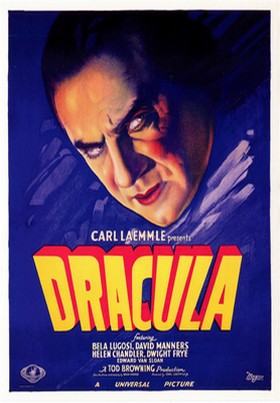 |
|

United
States, 1931
A Universal Pictures Production
75 mins, black & white, 1.37:1 aspect ratio
(original 1.20:1)
Shot on 35mm film
Director - Tod Browning
Screenplay - Garrett Fort
Cinematographer - Karl Freund
Production Design - John Hoffman, Herman Rosse
(uncredited)
Make-Up - Jack P. Pierce (uncredited)
Editor - Milton Carruth
Music - no original score
Bela Lugosi
(Count Dracula), Helen Chandler (Mina), David
Manners (John Harker), Dwight Frye (Renfield),
Edward Van Sloan (Van Helsing), Herbert Bunston
(Doctor Seward), Frances Dade (Lucy)
|
|
| |
|
Monsters of the Movies
contained many ghouls and fiends my 13-year old
self had never heard of before browsing the
collection Denis Gifford had compiled for his
readers, but there were a few familiar names and
characters, and Dracula was one of them.
Monster
number 19 in Gifford's alphabetic roll-call, the
basic facts concerning Count Dracula were known
to me thanks to Marvel Comics' Tomb
of Dracula, which I had been avidly
reading for a year before picking up Monsters
of the Movies - a somewhat fitting
connection, since Gifford himself was an avid fan
and collector of (British) comic books.
The image of
Bela Lugosi closing in on his victim was
certainly one of the most evocative stills used
in Monsters of the Movies, and together
with more stills from the movie published in A Pictorial History of Horror Movies
(which I discovered at my local WH Smith and
bought only a week or so after picking up
Monsters
of the Movies) it compelled me to get ahold
of and read Bram Stoker's original novel in
record time.
|
|
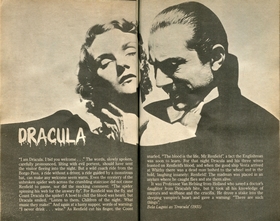
(Carousel Books / Transworld
Publishing)
|
|
| |
| Bram Stoker's 1897
novel Dracula was first published in the
United States in 1899 - and immediately fell into
the public domain due to Stoker's failure to
follow proper US copyright procedures. However,
when Hollywood produced the first sound version
of the vampire count's tale in 1931, director Tod
Browning’s Dracula wasn't actually derived
from Stoker’s novel but rather based on a
theatrical adaptation by Hamilton Deane and John
Balderston which had stripped the novel to its
core so that the central conflict could be
portrayed on a stage. Dracula: The Vampire Play was set
in two locales only: Dr. Seward’s parlour
and Carfax Abbey. Jonathan Harker’s travel
to Transylvania, Dracula's voyage to England by
ship, and the pursuit of the Count to
Transylvania had all been eliminated. Enjoying
continuous success since its opening in New York
in 1927, it was this play which prompted
Universal to produce a film version. Carl Laemmle
Jr., who had taken charge of the studio's
operations in 1930 and was himself a great fan of
"fright movies", had originally cast
classic horror actor Lon Chaney for the title
role.
However, within a month
of acquiring the film rights to Dracula,
Chaney died of cancer and the Great Depression
hit Hollywood.
|
|
| |
| With no star and half a budget,
Laemmle fell back entirely on the Broadway
production and took on two actors who had already
portrayed their characters on the stage: Bela
Lugosi as Count Dracula and Edward van Sloan as
Dr. Van Helsing. Dracula
was a roaring success for Universal, casting
the mould for what would become a trademark: the
1930s Universal horror movie. Creating a thick
layer of atmosphere through imposing sets,
craning shots and the use of sound was one part
of the success formula - iconic actors would
become the other agent. Ten months before Boris
Karloff shaped the visual concept of the
Frankenstein Monster for ever, Bela Lugosi's
portrayal of Dracula as a foreign predator in the
guise of aristocratic sophistication became the
role model for most vampire portrayals to come
(Frank, 1974).
His outward appearance was
very much in line with Stoker's descriptions - a
tall figure clad in black (underscored by the use
of a cloak) - and Browning's close-ups and
low-angles in addition to underlighting gave
Dracula a fearful appearance and created a
dramatic horror effect by distorting
Lugosi’s facial features.
|
|
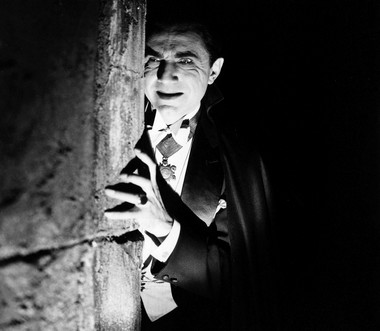
|
|
| |
| The movie has had a profound and
lasting impact by bringing mainstream acceptability to
the horror genre, and it also shaped the perception of
vampires forever. Lugosi's Dracula provides a stark
contrast to Max Schreck's Nosferatu, portraying the count
as a suave and elegant persona whose terrors lurk beneath
his appearance. Possibly the ultimate star of the movie,
however, are the studio sets by John Hoffman and Herman
Rosse, who were both unbilled in the film's credits but
provided work in a league of its own. |
| |
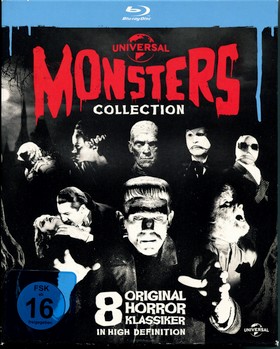
|
|
Oddly enough (given the film's
high profile), it took me a very long time to
actually see the movie. My current copy comes
from a 2013 Universal release of 8 classic horror
movies on high-definition Blu-ray. The film has
been carefully and meticulously restored from the
original nitrate camera negatives with an
amazingly stunning (given the movie's age)
1080p/AVC MPEG-4 encode. After decades of
washed-out renditions on TV and VHS, the amount
of visible definition on this Blu-ray provides
details previously lost, enhanced by stable
contrast with deep and eerie shadows - the
rightly famous sets have never looked better. The
audio was also meticulously restored and
remastered; according to an interview contained
in the extras the mono tracks proved a difficult
challenge and were carefully worked on without
losing the integrity of the original design. The
end result provides clear dialogue, music and
background acoustics. There
are plenty of extras on the history of the
individual movies, including notes on
restauration, along with the Spanish version
which was famously shot during night sessions and
produced for the Latin American market - before
dubbing became an established part of the cinema
trade.
Whilst undoubtedly a
formative classic, Dracula is very much
a masterpiece with quite a few flaws.
|
|
| |
| In spite of veteran cameraman
Karl Freund's camera and lighting techniques adding an
enormous amount of depth and atmosphere, the film has
both a very distinct theatrical flavour (with extended
periods of silence and character close-ups for dramatic
effect) and a sense of echoes from the silent era (such
as using two expository screen titles and a closeup of a
newspaper article to advance the story). |
| |
| The likeness to a silent movie
extends, to some degree, to the acting - a
feeling shared by a number of individuals
involved, including Edward Van Sloan, who
reprised his stage role of Van Helsing on screen
but quite bluntly felt that the movie was
"overplayed, overwritten, and altogether
lousy" (Mank, 2017), whilst David Manners
(who played John Harker) even felt that Bela
Lugosi - perceived by the crew as polite but
always mysterious and distant - wasn't actually
acting but rather "just being the odd man he
was" (Mank, 2017). The
movie also shows some sloppy editing and a few
obvious continuity issues, all said to be the
result of a chaotic and troubled production and a
distinct lack of interest on Browning's side.
And finally, the film lacks a specifically
composed musical score. A cost-saving move (that
helped complete the film $14,000 under budget),
what little music there is was taken from
Tchaikovsky's Swan Lake, Wagner's Meistersinger
von Nürnberg, and Schubert's "Unfinished
Symphony" in B minor.
|
|
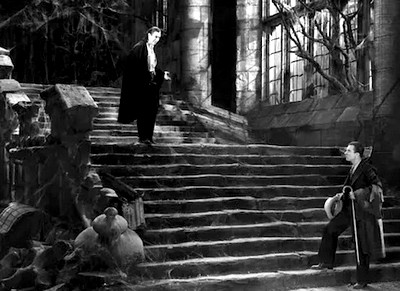
|
|
| |
| Although always seen as the
personification of Dracula after this film, Lugosi would only play the role of the
vampire count one more time on film - in the 1948 spoof Abbott
and Costello meet Frankenstein. An attempt at a
comeback in the role on stage in the UK in 1951 ended in
an unmitigated desaster (O'Rourke, 2020); Lugosi
died five years later, famously buried in his Dracula
cape. |
| |
| Only two
years after Lugosi's death, the vampire count
made a comeback, in Hammer's 1958 widescreen
Technicolor Dracula (released as Horror
of Dracula in the US), and moviegoers were
handed a new iconic rendition of Stoker's famous
creation at the hands of actor Christopher Lee. Interestingly enough, Lee
(who eventually played Dracula in a total of ten
movies, seven of which were Hammer productions),
didn't think too highly of Lugosi's 1931
performance.
"I was so
disappointed. I absolutely had been wanting
to see [the Lugosi Dracula movie] for a long,
long time. There are aspects of it, for
instance, that I considered ridiculous.
Dracula is played too nice at the beginning.
Practically no menace in the character -
there is no shock or fright in it."
(Rhodes, 2006)
In stark contrast, Gary
Oldman (who played Dracula in Francis Ford
Coppola's opulent 1992 Bram Stoker's Dracula)
rated Lugosi's rendition very highly, declaring
him to be his favourite Dracula (Stuart, 1997).
|
|
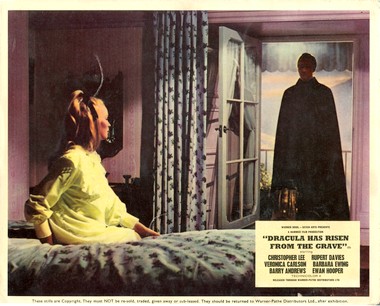
Christopher Lee in his iconic
role as Dracula - Original 1968 Lobby Card for
Hammer's Dracula Has Risen from the Grave
(personal collection)
|
|
| |
| |
| |
|
| |
| |
| |
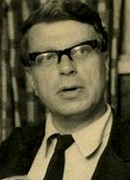 |
|
Denis Gifford on Dracula
in A Pictorial History of
Horror Movies (1973)
"Dracula
(1931) [was] the first horror film, and
Bela Lugois the first horror film star.
No Chaney, Lugosi forswore the makeup box
for the smooth hair and black cloak (...)
his voice was laced with melodic menace;
a natural aid was his native accent
which, like his acting, was strictly from
Hungary (...) ultimately a handicap,
Lugosi's curious cadence added a queasy
quality to the voice of the vampire (...)
a moody piece due less to Browning than
his gifted cameraman, the fabulous Karl
Freund. Yet antique as Dracula
undoubtedly is, it can still hold an
audience in thrall. That it is the oldest
talkie still playing commercially is due
entirely to the hypnotic performance of
its star."
|
|
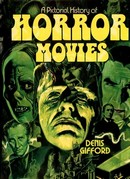 |
|
| |
|
| |
| |
| SOURCES FRANK
Alan (1974) Horror Movies - Tales of Terror
in the Cinema, Octopus Books
GIFFORD Denis
(1973) A Pictorial History of Horror Movies,
Hamlyn
MANK Gregory
William (2017) Bela Lugosi and Boris Karloff: The
Expanded Story of a Haunting Collaboration, With a
Complete Filmography of Their Films Together,
McFarland Inc.
O'ROURKE John
(2020) "A
Dracula disaster: When Bela Lugosi came to Britain",
BBC Website, 28 October 2020
RHODES Gary Don
(2006) Lugosi: His Life in Films, on Stage, and in the
Hearts of Horror Lovers, McFarland Inc.
STUART Roxana
(1997) Stage Blood: Vampires of the 19th Century
Stage (2nd edition), Bowling Green
University Popular Press
WEAVER Tom,
Michael Brunas & John Brunas (1990) Universal
Horrors, McFarland Inc.
|
| |
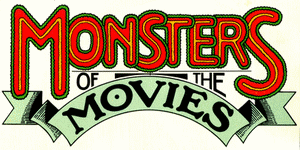
Back
to main index page
|
| |
|
| |
The illustrations presented here are
copyright material.
Their reproduction in this non-commercial review
and research context is considered to be fair use
as set out by the U.S. Copyright Act of 1976, 17
U.S.C. par. 107
and in accordance with the the Berne Convention
for the Protection of Literary and
Artistic Works.
All images from
Monsters of the Movies
(Carousel/Transworld) were scanned from my
personal copy purchased in 1977
All images of Blu-ray or DVD covers were scanned
from my personal copies
All images of lobby cards were scanned from
copies in my personal collection
Page created 13
August 2023
Last updated 2 September 2023
(c)
2023

|
|
| |











